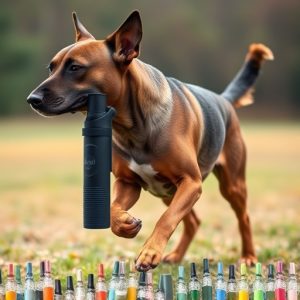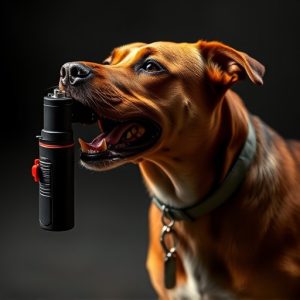Dog Pepper Spray Range & Legal Restrictions: Maximize Deterrence Safely
Dog pepper spray, using capsaicin from chili peppers, is a non-lethal canine behavior tool, but its…….
Dog pepper spray, using capsaicin from chili peppers, is a non-lethal canine behavior tool, but its use is restricted in many U.S. states due to animal welfare and public safety concerns. These 'Dog Pepper Spray Restricted States' have laws prohibiting or regulating its application, with strict guidelines on concentration and permit requirements. Effective use requires targeting sensitive areas from 10-15 feet away, following product instructions, prioritizing safety, and understanding local restrictions to avoid legal issues. Alternative methods like ultrasonic devices, motion-activated sprinklers, clickers, and positive reinforcement training offer humane solutions for managing canine behavior without the controversies tied to restricted states.
“Unleashing control over canine intruders? Discover the power of dog deterrent spray, a non-lethal solution for managing unwanted four-legged visitors. This comprehensive guide explores the science behind dog pepper spray, its active ingredients and why they work, and legal aspects, including the growing list of Dog Pepper Spray Restricted States. Learn expert application techniques to ensure maximum effectiveness while understanding safety precautions and considering alternative methods.”
- Understanding Dog Pepper Spray: Active Ingredients and Their Effectiveness
- Legal Considerations: Dog Pepper Spray's Availability and Restricted States
- Application Techniques: Maximizing the Reach and Impact of the Spray
- Safety Precautions: Using Dog Deterrent Spray Responsibly
- Alternative Solutions: Exploring Non-Spray Methods for Dog Control
Understanding Dog Pepper Spray: Active Ingredients and Their Effectiveness
Dog pepper spray, also known as capsaicin spray, is designed to deter dogs by targeting their sensitive olfactory system. It’s a non-lethal option for managing and controlling unwanted canine behavior. The active ingredient in dog pepper spray is capsaicin, derived from chili peppers. This compound stimulates nerve endings in the eyes and nose, causing temporary discomfort, tears, and a burning sensation. When sprayed, it creates an immediate barrier that discourages dogs from approaching or engaging with a particular area.
The effectiveness of dog pepper spray can vary based on factors like the concentration of capsaicin, weather conditions, and the target dog’s sensitivity. While it’s widely available in many states, there are Dog Pepper Spray Restricted States where its use is regulated or prohibited due to concerns regarding animal welfare and public safety. Always check local laws and regulations before purchasing or using dog pepper spray to ensure compliance with your area’s specific restrictions.
Legal Considerations: Dog Pepper Spray's Availability and Restricted States
Dog pepper spray, also known as capsaicin spray, is a popular deterrent for dog owners seeking to protect their property and pets from unwanted canine intruders. However, it’s essential to understand that its availability and legality vary significantly across different regions. While some states have no restrictions on the possession of pepper spray for personal use, others have implemented stringent regulations, especially when it comes to dog-specific deterrents.
In the United States, for instance, dog pepper spray is generally legal, but certain states have specific rules in place. Some states have banned or restricted its use entirely, particularly for non-lethal self-defense purposes. These restrictions often aim to protect both animals and their owners from potential harm. Dog pepper spray restricted states typically require permits or have stringent guidelines on the type and concentration of capsaicin allowed, ensuring that only specialized law enforcement or professional animal control agencies can utilize such sprays.
Application Techniques: Maximizing the Reach and Impact of the Spray
Maximizing the reach and impact of dog deterrent spray is key to its effectiveness. Users should aim directly for an aggressor dog’s face, eyes, and nose—sensitive areas that can quickly deter unwanted behavior. Spraying from a safe distance, typically 10-15 feet away, allows for maximum range while minimizing the risk of cross-contamination or accidental exposure. It’s crucial to follow product instructions regarding spray pattern and duration, as proper application directly influences success rate.
Understanding Dog Pepper Spray Restricted States is also essential. Due to potential risks and varying regulations, dog pepper spray availability and usage laws differ by state. Before purchasing or deploying any dog deterrent spray, check local legislation to ensure compliance and avoid legal repercussions.
Safety Precautions: Using Dog Deterrent Spray Responsibly
When using dog deterrent spray, safety should always be the top priority. It’s important to note that dog pepper spray, much like any other chemical irritant, carries risks and should be handled with care. Always ensure good ventilation in the area where you’ll be using it, and never aim or spray directly at people or pets. Keep out of reach of children and store in a secure location.
In many regions, dog pepper spray use is heavily regulated due to its potency and potential for misuse. Several states have specific laws restricting or prohibiting the sale, possession, or use of dog pepper spray. Before purchasing or using any form of dog deterrent spray, it’s crucial to research and understand these restrictions in your area. Remember that responsible use means adhering to legal guidelines and prioritizing safety above all else.
Alternative Solutions: Exploring Non-Spray Methods for Dog Control
While dog pepper spray is a popular and effective deterrent, it’s important to note that its use isn’t universal or even legal everywhere. Dog pepper spray restricted states highlight the growing concern over the potential harm and misuse of such products. As a result, many areas have implemented regulations limiting or banning the sale and use of dog pepper spray due to health and safety risks.
Alternative solutions for dog control are emerging, offering non-spray methods that prove just as effective. These include ultrasonic devices that emit high-frequency sound waves unpleasant to dogs, motion-activated sprinklers that startle them with a burst of water, and training aids like clickers and positive reinforcement techniques. These humane options not only avoid the potential dangers associated with spray but also foster better behavior through consistent, gentle guidance.
Dog pepper spray can be an effective tool for deterring unwanted canine interactions, but understanding its range and legalities is key. While it offers a non-lethal means of control, users must adhere to safety precautions and explore alternative methods when applicable. Knowing the active ingredients, application techniques, and legal considerations in Dog Pepper Spray Restricted States ensures responsible use. By combining these strategies with alternative solutions, individuals can effectively manage dog interactions while respecting both animal welfare and local regulations.


